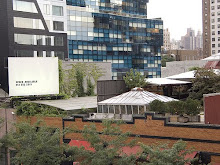


1) The Metropolitan Opera House, designed by Wallace Harrison, stands at the center of Josie Robertson Plaza and what is called the Lincoln Center "campus." 2) Architect Max Abramovitz designed Avery Fisher Hall, home theater of the New York Philharmonic. 3) The David H. Koch Theater, formerly known as the New York State Theater, houses both the New York City Ballet and the New York City Opera. The building is designed by Philip Johnson.
70 Lincoln Center Plaza (between West 62nd and 65th Streets and Columbus and Amsterdam Avenues)
1 to 66th Street/Lincoln Center Station, A/B/C/D/1 to 59th Street/Columbus Circle
Home to the Metropolitan Opera, the New York Philharmonic, the New York City Ballet, and the Juilliard School, among other institutions, the Lincoln Center for the Performing Arts is now best known as a cultural hub of New York City – a center of artistic performance and excellence. But what Lincoln Center represents today belies the lesser-known story of its construction. As part of the “Lincoln Square Renewal Project” of the 1950s, the history of Lincoln Center is deeply intertwined with the history of urban renewal in New York City.
The federal urban renewal program gained notoriety following its heyday in the 1960s and 1970s, but it was originally created as a provision of the Housing Act of 1949. In its infancy, it appealed to diverse interests, including those of city officials, big business, and social reformists. “More specifically, advocates of low- and moderate-income housing thought it would increase the stock of decent, affordable dwellings in the central cities.”[1] However, the ambiguity of the legislation allowed for the construction of “nonresidential developments,” though “improved housing seemed to be the principal goal.”[2] Lincoln Center, under the direction of John D. Rockefeller and the guiding philosophy of Robert Moses, was one such “nonresidential” development. Placed in the Upper West Side, at the time an area long marked by “decay and disinvestment,”[3], Lincoln Center was to be an impressive cultural complex as well as a “catalyst”[4] for private reinvestment and a re-making of the Upper West Side.
Construction, as it always does, required land, and the land allocated for Lincoln Center encompassed eighteen city blocks of slums. This area, mostly populated by Puerto Rican immigrants,[5] was seized through eminent domain and razed, displacing around 7,000 families in the process.[6] While slum clearance became a practice often equated with urban renewal, the underlying assumption by early advocates of federal redevelopment was compensation in the form of new, improved, and affordable housing. Lincoln Center, in fact, did include the construction of 4,400 apartment units in its development plan. However, 4,000 of these units were luxury apartment dwellings.[7] Affordable housing, it seems, did not fit the bill for Lincoln Center’s grandiose plans.
Over the years, Lincoln Center expanded its complex of buildings, enlisting an all-star roster of world-renowned architects to design various structures. In terms of revitalizing the neighborhood, and spurring growth and investment, Lincoln Center was a grand success. It continues to occupy a monolithic role in New York City’s cultural and performing arts scene, while the Upper West Side remains one of the wealthiest (and most expensive) neighborhoods in the city. However, with growth often comes loss. As Teaford writes, “Too often the victims of redevelopment are the poor, because slum clearance means removing them for the benefit of the rich and powerful.”[8] Though Teaford neglects to connect “the poor” with people of color, this is a connection that exists in U.S. narratives of racism and subordination, especially in areas of housing and redevelopment. Despite the cultural significance that Lincoln Center holds today, its history cannot be separated from those that suffered for its construction.
Works Cited:
Roth, Leland M. American Architecture: A History. Boulder: Westview Press, 2003.
Teaford, Jon C. “Urban Renewal and its Aftermath.” Housing Policy Debate. 11.2 (2000): 443-465.
Wilson, David. “Urban Revitalization on the Upper West Side of Manhattan: An Urban Managerialist Assessment.” Economic Geography. 63.1 (1987): 35-47.

No comments:
Post a Comment